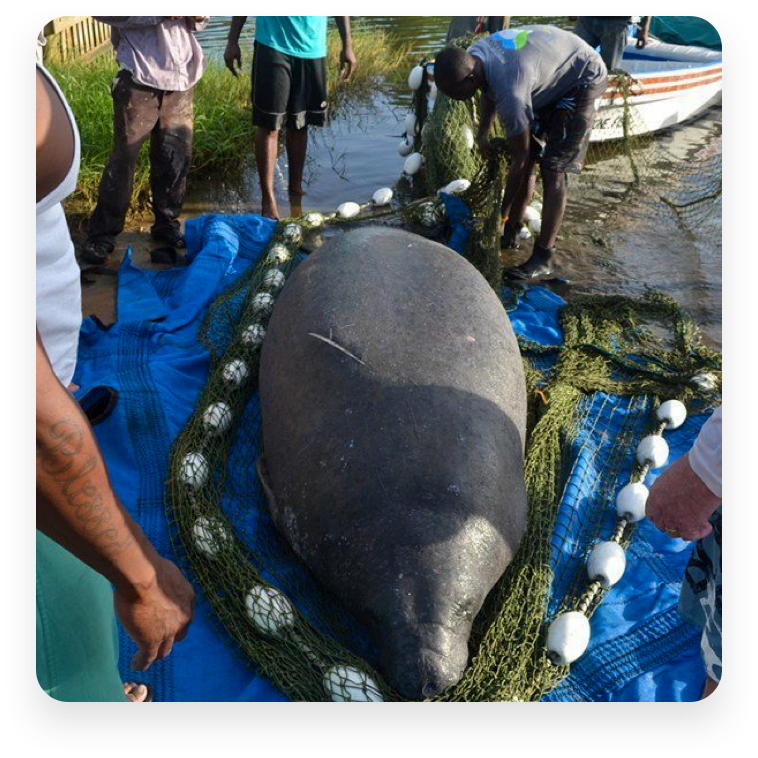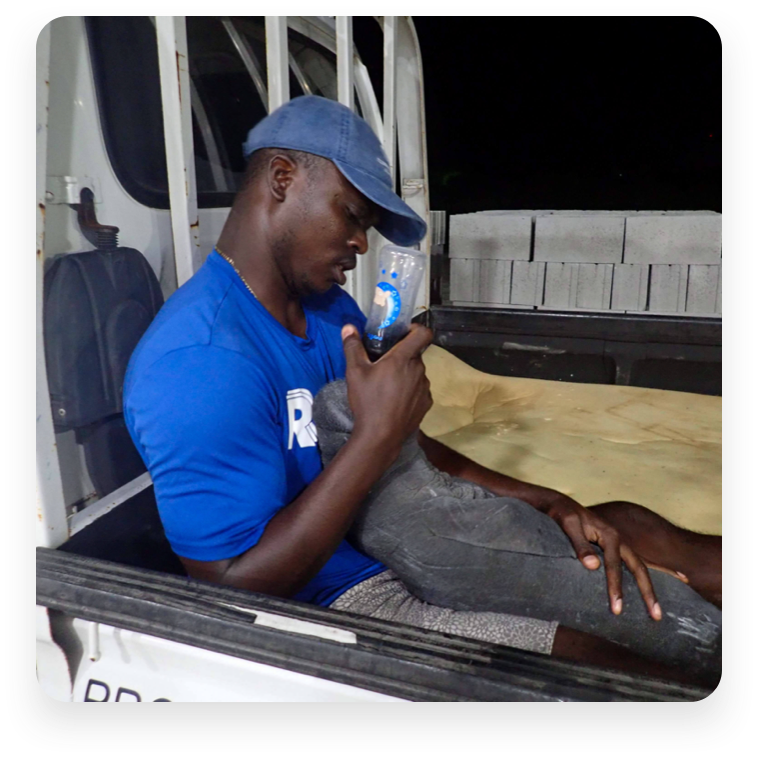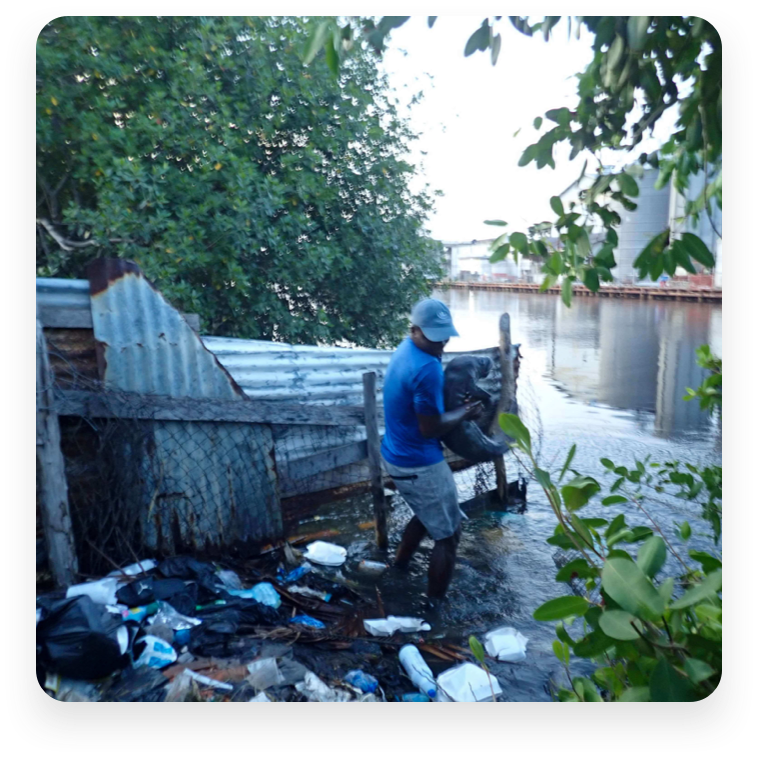Building Awareness and Teamwork for Country-Wide Manatee Conservation

Manatee Conservation in Belize
In 1997, Dr. James “Buddy” Powell, Bob Bonde of USGS, Nicole Auil of the Belize Coastal Zone Management Authority and a Sea to Shore (now CMA Research Institute) associate research scientist, began the Belize manatee conservation project.
Belize has the highest known density of Antillean manatees, a subspecies of the West Indian manatee, in the world. Unfortunately, because of rapidly increasing coastal development, human-related manatee deaths are rising quickly. Poaching, once the major threat to manatees in Belize, has been replaced by boat kills and destruction of habitat as the major concerns for the survival of the species.
CMA Research Institute scientists and collaborators provide the data, expertise and scientific exchange that are used by the Belize government to establish sanctuaries, speed zones, laws and regulations that safeguards manatees and other actions that help ensure the survival of manatees in this remarkable country.
Jamal Galves was just a boy at age eleven when he met Buddy at the dock preparing to head out for manatee health assessments. He asked if he could join the team and began volunteering in efforts to protect the manatee of Belize. After years of expressing his devotion, interest and passion for the conservation of the endangered manatees, Jamal was officially hired as a Field Assistant in 2008. Today, he is now the Belize Manatee Conservation program coordinator.

Program Activities
- Conduct countrywide community-related education and outreach programs coordinate the Belize Marine Mammal Stranding Network.
- Serve as a resource and representative on relevant government and local committees, such as the Belize Manatee working group.
- Track and monitor tagged, wild manatees.
- Create public information brochures and posters on manatees and their habitat.
- Communicate with the media and the public on manatee conservation issues.
- Continue critical fundraising efforts for our programs and handle all aspects of managing, administering, and maintaining an active research and conservation program in Belize.

Jamal Galves in Belize
We are very pleased to announce that Jamal Galves, our Associate Research Biologist in Belize, has been honored with the Meritorious Service Award from the Governor-General of Belize, in recognition of his dedication to conserving the manatee population there. Jamal is the youngest Belizean to have received this prestigious award. His efforts include public education and outreach in local schools, manatee rescues and relocations, and collaborating with government and area officials to make stronger regulations in “no-wake zones” near Belize City. Congratulations Jamal!
One of Jamal’s guiding quotes:
We must allow our children the right to experience the beauty of Belize that we have had the fortune to share. We must, in addition teach the next generation the idea of conservation for, if we fail, we had better teach them survival
Manuel Esquivel, 1994
Help Support Manatee Research

Examples of Program Success
Speed Reduction and No-Wake Zones
Implemented speed zones and installed and maintain no-wake zone signage in the waters off Belize City.
Decreased Poaching
Through research and awareness efforts we have decreased poaching incidents in the country. In 2010 a poaching incident in Belize was prosecuted. This is the first time anyone has been prosecuted for killing a manatee in Belize.
Population Monitoring
We have successfully captured and carried out health assessments on 164 individuals since 1997. The data set we have gathered over the years through consistent health assessments of this wild population is helping to provide vital information on the population’s status, and what measures and efforts still need to be taken to ensure manatees continue to exist.
Rescue, Rehab, and Release
Our Belize team has successfully rescued and transported many injured, sick or orphaned manatees to a rehabilitation facility for care, and have reintroduced and monitored those animals in the wild following recovery.
Conservation Leadership
Carried out a conservation leadership project that successfully lowered the number of manatee deaths in an area that is responsible for the most manatee deaths in the region.
Description
The Antillean manatee is a subspecies of the West Indian manatee as is the Florida manatee.
- All West Indian manatees share these characteristics:
- they are gray or brown with two flippers that have 3-4 nails (they don’t really hold food with their flippers except in captivity when they’re fed lettuce). The females are larger than males. The Antillean manatee is slightly smaller than the Florida manatee.
- What They Eat
- The Antillean manatee is primarily herbivorous and feeds on a wide variety of submerged, floating, and shoreline vegetation.
- Weight
- 440 to 1,320 lbs.
- Length
- 8.5 – 11.5 feet
- Greatest Threats
- Human threats include entanglement in fishing gear, hunting – though it is illegal and lack of public awareness of how to protect this gentle marine animal. All manatees face the threat of injury or death from cold stress if they lack access to warm waters.
Making Waves
- 1600+ rescued sea turtles since 2010
- 2100+ Nests monitored since 2010
- 850+ Animals released since 2010
- 190K Volunteer Hours 2020-2021
